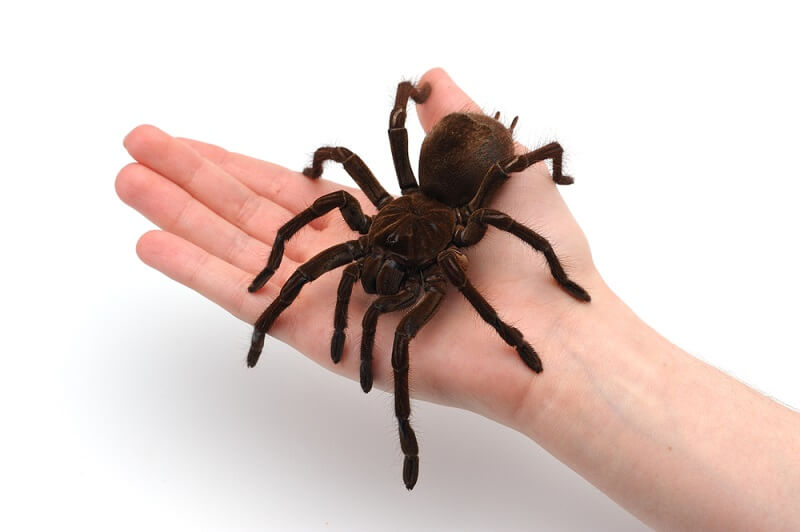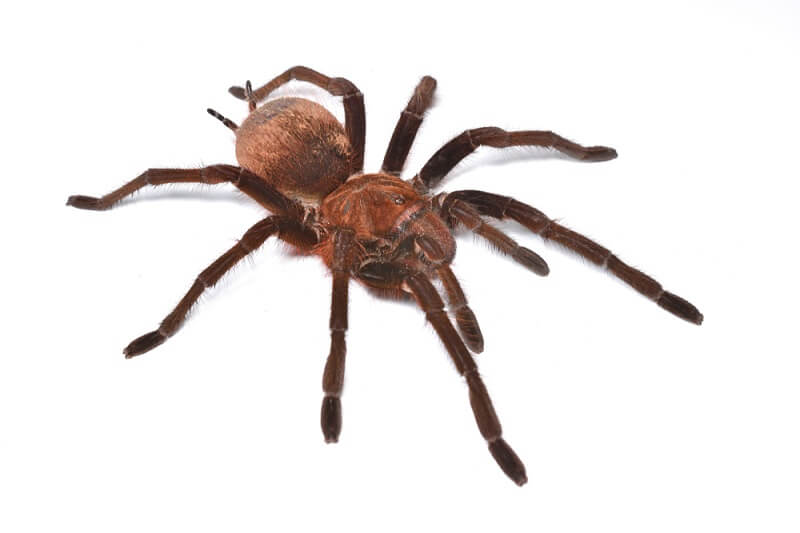
The Goliath birdeater is the world’s largest spider, by weight. Technically, the giant huntsman spider has longer legs – but it weighs considerably less! While this massive tarantula is called a “bird-eater,” this name is actually a bit of a misconception. Goliath birdeaters rarely, if ever, eat birds! That being said, goliath tarantulas have a voracious appetite. They eat large insects, worms, and many different kinds of amphibians. Sometimes, they even catch a small rodent, lizard, or snake. Part of the reason that goliath birdeaters do not regularly eat birds is that they are ground-dwelling. Instead of climbing through the canopy looking for prey, goliath birdeaters tend to hide on the forest floor in swampy areas. By creating a burrow in the ground or under a log, the goliath can hide throughout the day. As a nocturnal predator, life begins for the goliath birdeater as the sun goes down. Throughout the rainforests of northern South America, these massive tarantulas roam the forest floor at night. Those massive fangs are loaded with venom – capable of paralyzing and killing small animals. Once captured, these small prey items will be dragged back to the burrow. They are injected with digestive enzymes, and the liquefied nutrients are sucked out! While they are the biggest spider in the world, goliath birdeaters are not the most dangerous. Their venom is mild to humans, roughly equivalent to getting stung by a wasp. In fact, the venom will likely do less damage to humans than the goliath’s massive fangs! However, it is not the fangs you should worry about with a goliath birdeater. If a goliath is intimidated by you, they may start to “hiss” – a defensive sound meant to scare away predators. If you listen and back off, it is very unlikely you will get bitten as these tarantulas tend to only bite in self-defense. If you don’t take the hint, the tarantula may first try to deploy its urticating hairs. These hairs – found on the tarantula’s abdomen – have evolved to be a defensive weapon. Much like pepper spray, these small hairs can irritate the skin, eyes, and respiratory tract. In fact, it is more likely that a person has a severe allergic reaction to these urticating hairs than goliath venom! In spite of these slight dangers, goliath birdeaters serve a few different roles in human society. Many cultures in South America consume the tarantulas after roasting them, and they are said to have a pleasant, shrimp-like flavor! Many insect and reptile hobbyists also keep goliath birdeaters as pets. Surprisingly, female goliaths can live up to 25 years – so you shouldn’t buy a goliath birdeater lightly! While the goliath birdeater may be one of the largest living spiders, it can serve as more than just a feature of your nightmares! In fact, the goliath birdeater is an excellent example of several very important biological concepts! Stridulation is the act of rubbing two body parts together to create a vibration. Much like the wooden frog toys that “chirp” when a stick is rubbed across the ribbed top, goliath tarantulas can produce a hissing noise by rubbing hairs together around their mouth. These bristly hairs, when vibrating together, create a very noticeable noise. Typically, goliath birdeaters only stridulate when they are threatened. This ensures that they are seen by any large animals about to accidentally step on them. The hissing noise may also be a repellent to some predators. The hissing sound is often accompanied by another defense – the release of irritating hairs from the abdomen! Predators may learn to associate the hissing noise and the painful, irritating hairs. While some tarantulas use stridulation as a form of defense, most other spiders are silent. However, stridulation is seen widely throughout the world of arthropods. Many insects use stridulation to attract mates – such as the crickets you can regularly hear on summer nights. But, stridulation is not limited to the insects. Some fish and snake species are known to stridulate for various reasons! All spiders, from the tiniest orb-weavers to the massive goliath birdeater, are part of the Arthropod phylum. All arthropods – from shrimp to dragonflies – have an exoskeleton instead of an endoskeleton like other animals. The exoskeleton of goliath birdeaters is covered in hairs that serve a variety of functions, from defense to sensory perception. While the exoskeleton keeps the spider safe and allows its muscles to function, exoskeletons do have a downside. Unlike bones – exoskeletons stop growing once they are formed! This means that insects, spiders, and crustaceans must constantly shed and reform their exoskeleton throughout their lives. So, many times throughout its life a goliath birdeater must find a safe place, break out of its old exoskeleton, and wait several hours while its new exoskeleton hardens. This does leave the spider vulnerable for several hours – but it is an efficient way to grow! While the goliath birdeater is by far the largest tarantula living today, it is tiny compared to some of the insects of the past. In fact, the goliath birdeater is much smaller than some of the fossilized spiders we have found! Insects today face a very different environment than they did millions of years ago. Arthropods left the ocean long before vertebrates evolved legs and left the ocean. So, they spent millions of years taking over the land. During this time, some of them grew to massive sizes – including dragonflies with a wingspan nearly 3 feet wide that lived nearly 300 million years ago!
Kingdom
Animalia
Phylum
Arthropoda
Class
Arachnida
Order
Araneae
Family
Theraphosidae
Genus
Theraphosa
Species
Theraphosa blondi
Niche
Predator
Length
Up to 12 in (about 30 cm)
Weight
Up to 6.2 ounces (175 g)
Lifespan
15-25 years for females, 3-6 for males
Social Structure
Mostly solitary
Conservation Status
Least Concern
Preferred Habitat
Marshy, swampy areas in South American Rainforests
Average Clutch Size
100-200 eggs
Main Prey Species
Large insects, worms, amphibians, rarely- birds, rodents, lizards, snakes
Predators
Many larger birds and mammals, some reptiles
The Basics
Is the Goliath Birdeater Dangerous to Humans?

Interesting Insights from the Goliath Birdeater!
Stridulation – A hissing tarantula?

Exoskeletons

Giant Insects
